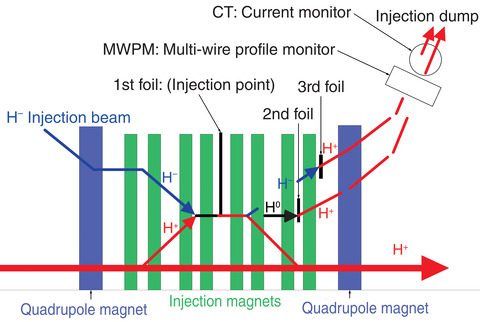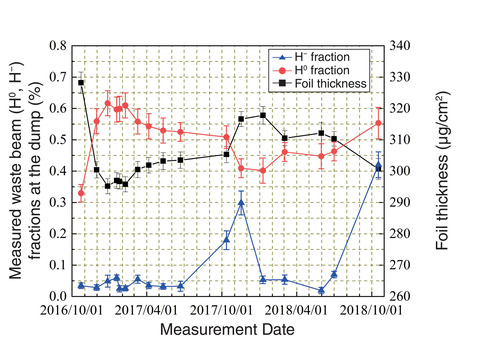
Fig.5-2 Schematic view of the charge-exchange injection system in the J-PARC 3-GeV synchrotron

Fig.5-3 Measured results of the waste beam using a current monitor (CT)
At the 3-GeV synchrotron in J-PARC (Japan Proton Accelerator Research Complex), the negative hydrogen (H-) beam from the linac is stripped to protons (H+) by using a thin carbon (stripper) foil for multi-turn charge-exchange, as shown in Fig.5-2. This injection method enables a high-current beam to be stored without expanding the beam size; for stable operation, however, the degradation of the foil must be monitored, as it is irradiated by the circulating beam as well as the injection beam. The partially stripped neutral hydrogen (H0) and unstripped H- fractions are called waste beams. They ideally represent a tiny fraction of the injected beam (0.3% and 10-5%, respectively) and are stripped to H+ by secondary foils and transported to the injection beam dump (I-dump) for disposal.
We established and implemented an online method to monitor stripper foil degradation by precisely measuring the H0 and H- fractions using a current monitor (CT) and a multi-wire profile monitor (MWPM) installed at the I-dump to clarify foil thinning and pinhole outbreak information, which indicate breakages in the foil. As H0 and H- fractions are ideally very small, we applied fast Fourier transform analysis to the CT data and monitored the signal corresponding to the chopping frequency of the injection beam, which was 1.23 MHz. The waste beam signal was clearly identified nearly two orders of magnitude above the noise level (measured with no beam). In a similar way, we also measured the total injected beam transporting to the I-Dump from which we obtained the waste beam fraction. Such a measurement by the CT provides a total fraction of waste beam (comprising H0 and H-) in the injected beam. Then, to obtain each individual fraction, the H0 fraction itself was measured by removing the third foil from the beam line (i.e., transporting only H0 to the I-Dump), which was performed during weekly beam tuning. Once the H0 and H- fractions were obtained, the H+ fraction that was stripped and injected into the ring was calculated to estimate the foil thickness at the time of measurement. The H0 and H- beam profiles were measured simultaneously by using the MWPM. Their trajectories are 80 mm separated and the profiles also have no overlap with each other. The integrated yield of each profile provides an individual charge fraction; however, the MWPM was only using during beam tuning, as it is not a completely nonintrusive device. On the contrary, the CT was kept online to continuously monitor the foil degradation during beam operation. The obtained CT data under continuous operation with a single foil for two years is shown in Fig.5-3. Early in the experiment, the foil rapidly thinned due to sublimation caused by beam irradiation; near the end of the experiment, the observed foil thinning and sharp increase in unstripped H- occurred due to shape changes (i.e., deformation) and the formation of pinholes in the foil. The foil was then replaced to avoid failure. Thus, our obtained data allowed us to estimate the foil lifetime as two years. Additionally, the observed excess of H- in the middle of the experiment (i.e., October 2017) was caused by the H- missing the foil because of insufficient tuning of the beam, but this problem was later fixed.
Overall, our research allows for the detailed changes of foil properties to be measured during beam operation. Using this system to observe high-intensity beam operation for two years without failure, we quantitatively evaluated the foil degradation and determined a realistic end of usefulness. Further, this work presents novel valuable data on the state change and lifetime of a thin stripper foil.
(Pranab Kumar Saha)
<Previous: 5 Neutron and Synchrotron Radiation Research | Next: 5-2>